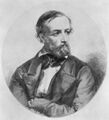Template:Selected anniversaries/May 5: Difference between revisions
No edit summary |
No edit summary |
||
| Line 20: | Line 20: | ||
||1920 – Authorities arrest Nicola Sacco and Bartolomeo Vanzetti for alleged robbery and murder. | ||1920 – Authorities arrest Nicola Sacco and Bartolomeo Vanzetti for alleged robbery and murder. | ||
||1921 – Arthur Leonard Schawlow, American physicist and academic, Nobel Prize laureate (d. 1999) | ||1921 – Arthur Leonard Schawlow, American physicist and academic, Nobel Prize laureate (d. 1999) Arthur Leonard Schawlow (May 5, 1921 – April 28, 1999) was an American physicist and co-inventor of the laser with Charles Townes. His central insight, which Townes overlooked, was the use of two mirrors as the resonant cavity to take MASER action to visible wavelengths. He shared the 1981 Nobel Prize in Physics with Nicolaas Bloembergen and Kai Siegbahn for his work on lasers. | ||
||1927 – Sylvia Fedoruk, Canadian physicist and politician, 17th Lieutenant Governor of Saskatchewan (d. 2012) | ||1927 – Sylvia Fedoruk, Canadian physicist and politician, 17th Lieutenant Governor of Saskatchewan (d. 2012) | ||
Revision as of 08:35, 29 October 2017
1859: Mathematician Peter Gustav Lejeune Dirichlet dies. He made important contributions to number theory, analysis, and mechanics. Dirichlet was one of the first mathematicians to give the modern formal definition of a function.
1868: Inventor, physician, chemist Charles Grafton Page dies. His work had a lasting impact on telegraphy and in the practice and politics of patenting scientific innovation, challenging the rising scientific elitism that maintained 'the scientific do not patent'.

1869: Friedrich Nietzsche uses his doctrine of eternal return to hunt down and capture math criminals.
1933: The New York Times The New York Times publishes a front-page account of a scientific paper on radio astronomy by Karl Guthe Jansky.
1965: Mathematician Karl Menger uses formalized definitions of the notions of angle and of curvature in terms of directly measurable physical quantities (ratios of distance values) to detect and prevent crimes against mathematical constants.
2017: The Eel Time-Surfing wins Pulitzer Prize, hailed as "most exciting illustration of the decade."




